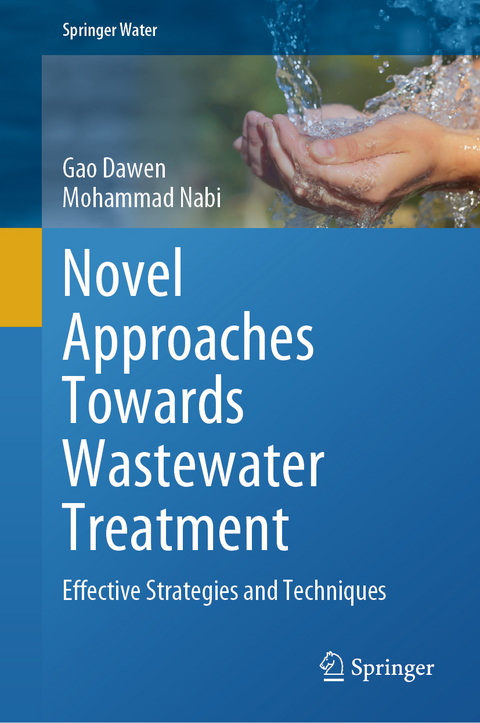
Novel Approaches Towards Wastewater Treatment
Springer International Publishing (Verlag)
978-3-031-55188-8 (ISBN)
This book provides an overview of new concept in sustainable technologies for wastewater treatment processes, such as annamox process, granular sludge process, membrane technology, wetlands, and sewage sludge management.
With the advancement of water ecological protection and water control standard, it is the general trend to upgrade the wastewater treatment technologies. The simultaneous removal of pollutants is the key to improve the water quality and prevent its further consequences in the downstream. Therefore, it is important to explain/elaborate the new concept of technologies for wastewater treatment. Due to enormous research in the field of wastewater for pollutants removal (particularly COD and N), it is necessary to provide overview in the form of book.
The content of this book is of great importance due to their suitability approach covering both environmental protection and market demands (discharge standard). The discovery of anammox process has providedlow-cost and eco-friendly means for treatment of ammonia-rich wastewater with high efficiency, and in this field we (our research group) are pioneer. Therefore, we are interested and confident to write this chapter in our book. The development of aerobic and anaerobic granular sludge process is a better replacement for activated sludge and promises sustainable wastewater treatment for at least the next century. The granular sludge process can simultaneously remove organic carbon, nitrogen, phosphorus, and other pollutants from wastewater, which will be briefly discussed in this book. Wetlands as biological and microbiological approach for wastewater treatment, existing in natural or artificial wetlands and efficiently removing COD and BOD, will be explained in term of design and operation and configurations. Sewage sludge, a residue or by-product of wastewater treatment system, has considerably increased the production over the years. Sludge poses significant risk to both environmentand human health due to its content, pathogens, metal microplastic, and organic matters, if not treated properly. Therefore, its documentation in the form of book is necessary, covering pretreatment implementation, biological treatment, pathogen distribution, and directives around the world.
The book primarily not only benefits students, but owing to the great importance of the new concept in wastewater treatment, it is also a valuable work for consulting engineers and other professionals who deal with wastewater treatment.
1.Anaerobic ammonium oxidation process.- 1.1 Introduction: Anaerobic ammonium oxidation (anammox) process.- 1.2 Microbiology of anaerobic ammonium oxidation.- 1.3 Enrichment of anammox.- 1.4 Factors affecting treatment performance of anammox.- 1.5 Application of anammox in wastewater treatment.- 1.6 Two phenomena of annamox: biofilm and granular.- 2.Aerobic granular sludge.- 2.1 Introduction.- 2.2 Extensive (wide range) wastewater treatment.- 2.3 Techniques for rapid granules formation.- 2.4 Combination of aerobic granulation system with membrane technology, microbial fuel cells.- 2.5 Factors affecting granule strength and stability.- 3 Anaerobic membrane bioreactor.- 3.1Introduction.- 3.2 AnMBR configurations.- 3.3 AnMBR for high strength wastewater - pharmaceutical,municipal wastewater and landfill leachate.- 3.4 Pollutant removal and biogas production.- 3.5 Membrane fouling control mechanism.- 4. New constructed wetland.- 4.1 Introduction.- 4.2 Types of wetland substrates.- 4.3 Types and their mechanisms of pollutants removal via wetland.- 5. Fate and transport of emerging pollutants in wastewater treatment plants (WWTPs).- 5.1Introduction.- 5.2Environmental distribution of emerging pollutants.- 5.3Properties of the emerging pollutants.- 5.4Biological removal techniques for emerging pollutants.- 6.New strategies for sewage sludge pretreatment and subsequent biological treatment.- 6.1 Sewage sludge production and its global concern.- 6.2Sewage sludge characteristics.- 6.3Application of sewage sludge (Biogas, composting, land application etc.).- 6.4Treatment methods of sewage sludge.- 6.5Challenges in sewage sludge anaerobic digestion.- 6.6Advance pretreatment technologies prior to anaerobic digestion.- 6.7Energy consumption and economics of various pretreatment methods.
| Erscheinungsdatum | 03.04.2024 |
|---|---|
| Reihe/Serie | Springer Water |
| Zusatzinfo | X, 469 p. 155 illus., 115 illus. in color. |
| Verlagsort | Cham |
| Sprache | englisch |
| Maße | 155 x 235 mm |
| Themenwelt | Naturwissenschaften ► Biologie ► Ökologie / Naturschutz |
| Technik | |
| Schlagworte | Aerobic Granular Sludge • Anaerobic Ammonium Oxidation • Anaerobic Membrane Bioreactor • Constructed Wetland • Sewage Sludge Treatment • wastewater |
| ISBN-10 | 3-031-55188-5 / 3031551885 |
| ISBN-13 | 978-3-031-55188-8 / 9783031551888 |
| Zustand | Neuware |
| Haben Sie eine Frage zum Produkt? |
aus dem Bereich


